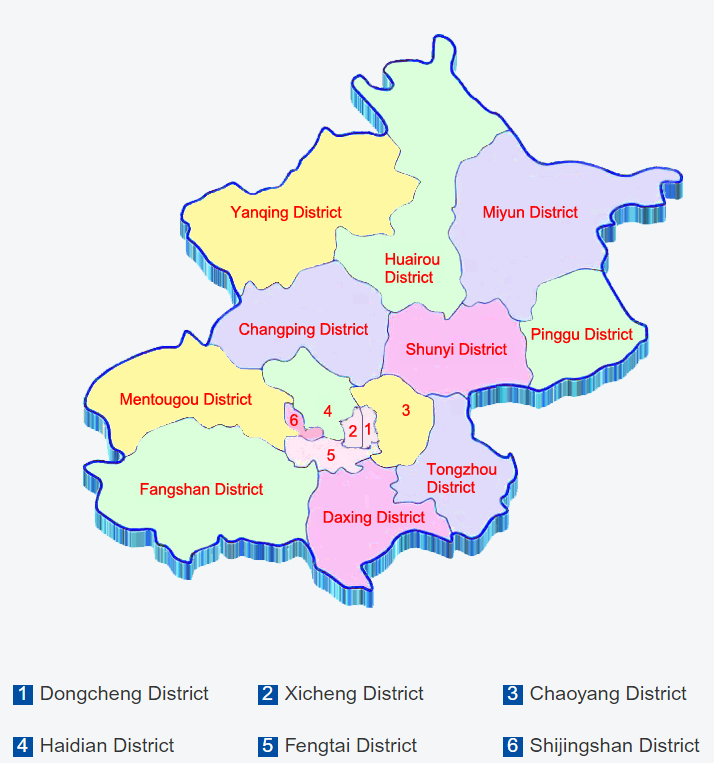Beijing is the capital of the People's Republic of China. It is the political center, cultural center, international communication center and scientific and technological innovation center of the country. It is a world famous ancient capital and a modern international city.
Administrative districts

Population
By the end of 2023, the city's population of permanent residents reached 21.858 million, marking an increase of 15,000 from the previous year. Of these residents, 19.198 million lived in urban areas (87.8 percent). The city also had a significant non-local permanent resident population of 8.24 million (37.7 percent of the total). While the birth rate among permanent residents was 5.63 percent, the death rate was slightly higher at 6.13 percent, resulting in a natural population decrease of -0.5 percent.
Despite this, the urban area added 281,000 new jobs throughout the year, maintaining a low average unemployment rate of 4.4 percent.
Demographic geography
Geographical Location
Beijing Municipality covers an area of 16,410.54 square kilometres (sq.km). Nestled on the north of the North China Plain, it borders Tianjin Municipality on the east and Hebei Province in all other directions. The Western Hills, west of Beijing, are branches of the Taihang Mountains while the Jundu Mountain, north of the city, is a part of the Yanshan Mountains. They intersect at Beijing's Guangou Valley, shaping a giant semi-circle curve opening to the southeast. This curve is called "Beijing Bay." All these tell us why Beijing has been acclaimed as a land of peace and prosperity since ancient times.
Topographic Features
Beijing has a higher northwest part and a lower southeast part. It is surrounded by mountains to its west, north and northeast. To its southeast, the North China Plain gradually descends towards the Bohai Sea. Mountain areas occupy about 62 percent of the municipality's total area. The Dongling Mountain, 2,303 metres above sea level, is Beijing's highest mountain. Five major waterways from west to east flow through the municipality: the Juma, Yongding, Beiyun, Chaobai and Jiyun rivers.
Climate
The capital has a temperate, continental monsoonal climate, characterised by short spring and autumns, hot and rainy summers, and cold and dry winters. Its average annual temperature is 11 to 14 degrees Celsius. Around 75 percent of its annual precipitation occurs in summer, with the heaviest rainfall in July and August.
Time Zone
Beijing is located in Greenwich Mean Time Zone 8(GMT+8). It is eight hours earlier than London (GMT+0). The whole of China adopts "Beijing time" as its standard time.
City Trees and City Flowers
City Trees
The city trees of Beijing are the Chinese scholar tree and the arborvitae. As a symbol of Beijing's far-reaching civilisation, they are among the municipality's main species of trees, and both have a long cultivation history here. The Chinese scholar tree is suited to Beijing's meteorological and soil features. It is a sunshine lover, characterised by resistance to droughts, high temperature, saline, alkaline and soil compaction. It is well adapted to urban soil with debris. As Beijing's oldest shade tree, the Chinese scholar tree is celebrated as the "king of shade trees." Peculiar to China, the arborvitae is a species of evergreen arbor. It is characterised by resistance to cold weather and droughts, delicate fragrance and a long life. Arborvitaes grow luxuriant in imperial parks, gardens, altars and temples, creating picturesque scenery in a solemn atmosphere.
City Trees
The city flowers of Beijing are the Chinese rose and the chrysanthemum. Also named yueyuehong ("red every month"), the Chinese rose is a native species of flower to China. It has a cultivation history of more than 1,000 years. The Chinese rose, hailed as the "queen of flowers," is one of China's ten famous blossoms. The plum blossom, orchid, bamboo and chrysanthemum are regarded as "four gentlemen" mainly because of their strong nature and elegance. The chrysanthemum, originating in China, has a cultivation history of over 3,000 years. Even though it frosts, the chrysanthemum does not fade easily. Representing the unyielding character of Beijingers, the chrysanthemum became the city flower of Beijing. Beijingers promote a traditional high level of applying chrysanthemums to ornamental moulds.





 Share:
Share: 






 京公网安备
11010802027341号
京公网安备
11010802027341号